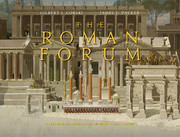Book contents
- Frontmatter
- Map
- Contents
- Preface
- Acknowledgments
- Part I. Architecture in the Roman Forum during the Empire: A Brief History
- Part II. The Monuments
- 3 The Temple of Antoninus and Faustina
- 4 The Temple of Caesar (Aedes divi Iuli)
- 5 The Basilica Æmilia
- 6 The Curia
- 7 The Arch of Septimius Severus
- 8 Minor Monuments
- 9 The Temple of Concord
- 10 The Temple of Vespasian
- 11 The Tabularium
- 12 The Portico of the Dei Consentes
- 13 The Temple of Saturn
- 14 The Basilica Julia
- 15 The Arch of Tiberius
- 16 The Schola Xanthi
- 17 The Diocletianic Honorary Columns
- 18 The Temple of Castor and Pollux
- 19 The Parthian Arch of Augustus (19 BCE)
- 20 The Temple of Vesta
- Part III. Conclusions
- Glossary
- Notes
- Bibliography
- Sources for Coin Images from the Internet and for Other Images
- Index
15 - The Arch of Tiberius
from Part II. - The Monuments
Published online by Cambridge University Press: 05 March 2015
- Frontmatter
- Map
- Contents
- Preface
- Acknowledgments
- Part I. Architecture in the Roman Forum during the Empire: A Brief History
- Part II. The Monuments
- 3 The Temple of Antoninus and Faustina
- 4 The Temple of Caesar (Aedes divi Iuli)
- 5 The Basilica Æmilia
- 6 The Curia
- 7 The Arch of Septimius Severus
- 8 Minor Monuments
- 9 The Temple of Concord
- 10 The Temple of Vespasian
- 11 The Tabularium
- 12 The Portico of the Dei Consentes
- 13 The Temple of Saturn
- 14 The Basilica Julia
- 15 The Arch of Tiberius
- 16 The Schola Xanthi
- 17 The Diocletianic Honorary Columns
- 18 The Temple of Castor and Pollux
- 19 The Parthian Arch of Augustus (19 BCE)
- 20 The Temple of Vesta
- Part III. Conclusions
- Glossary
- Notes
- Bibliography
- Sources for Coin Images from the Internet and for Other Images
- Index
Summary
Varus
The Arch of Tiberius (Figs. 0.3–4, 1.3, 8.9–12, 15.1–6, 21.22–26) was connected with one of the most terrible disasters of the reign of Augustus. By 9 CE, the Romans were beginning to expand in Germany. In 6 or 7, Augustus appointed Publius Quinctilius Varus, a member of the imperial family by marriage, as governor. Varus had enjoyed a long and successful political career including governorships in Africa (8–7) and Syria (7–4). In 6–7, Tiberius, Augustus’ adopted son and heir, was still fighting in nearby Pannonia, but Germany was relatively peaceful. With three legions, Varus marched through the partially pacified zone between the Rhine and the Elbe introducing the inhabitants both to Roman power and to the Roman administrative system. Described as placid in mind and body, he was reputed to be more accustomed to life in the camps than to campaigning. In endless legal proceedings, he behaved more like a “city praetor” than a general in command of an army in hostile German territory. Worse yet, treating the Germans like slaves, he exacted money from them.
A revolt was inevitable, and its potential leader, Arminius, shared Varus’ mess, seeming so friendly that Varus suspected nothing. At the last banquet before the beginning of hostilities (9), Segestes, a local chieftain and Arminius’ rival, urged Varus to arrest Arminius and his friends. If they were in Roman custody, he assured Varus, their leaderless followers would be immobilized. Varus could sort the whole matter out later. Varus, however, refused to listen to any accusations against his friend. Indeed, on Arminius’ advice, he broke up the Roman army into small local units that posted to police duties throughout the province
- Type
- Chapter
- Information
- The Roman ForumA Reconstruction and Architectural Guide, pp. 261 - 268Publisher: Cambridge University PressPrint publication year: 2015



